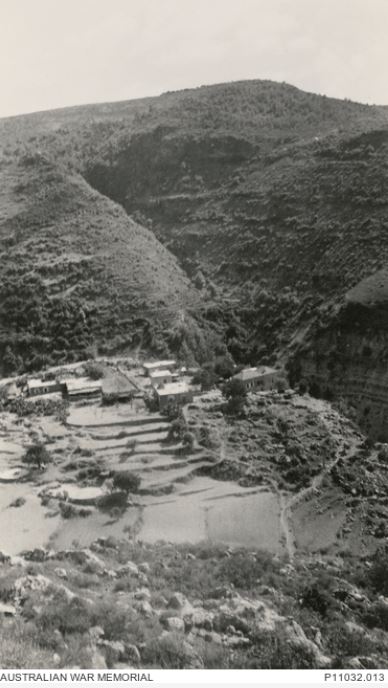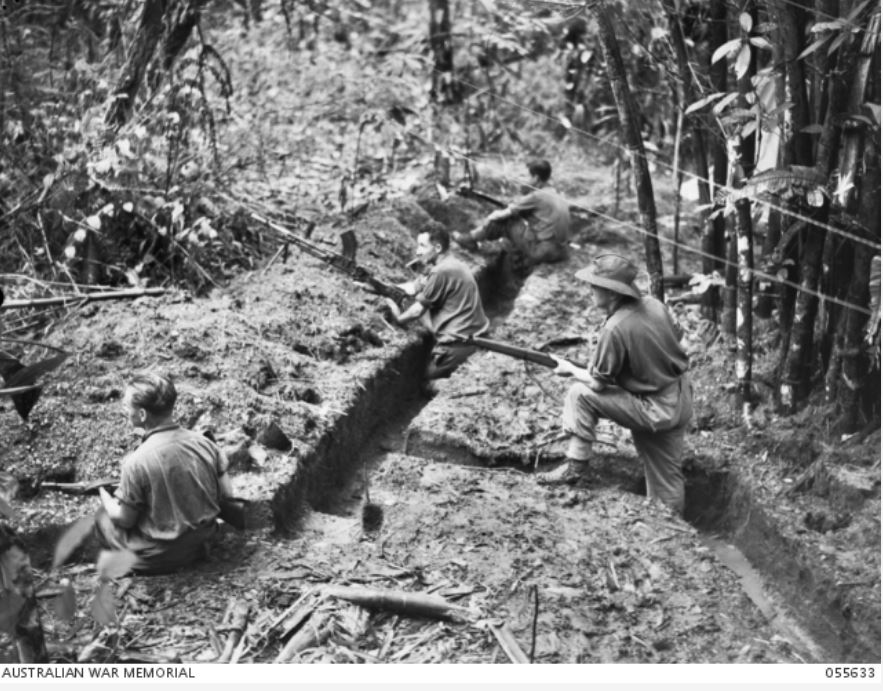2/6th Australian Infantry Battalion
From Our Contribution
 Wealthy Arab's farm on Damour River AWM photo P11032.013 | |
 10 Aug 1943 Goodview, New Guinea. Trench manned by 'D' Company members. AWM photo 055633 |
Contents
Brief History
The 2/6th Battalion stablished its headquarters at the Royal Melbourne Showgrounds on 25 October 1939, becoming a part of the 17th Australian Infantry Brigade' of the 6th Australian Infantry Division. It relocated to the new camp at Puckapunyal on 3 Nov 1939 to carry out its basic training, and departed Melbourne for service overseas on 14 Apr 1940.
Arriving in the Middle East on 18 May, the 2/6th spent the rest of 1940 conducting further training in Palestine and Egypt. Just before Christmas, it embarked on its first campaign, against the Italians in eastern Libya (Cyrenaica). Its first battle, fought at Bardia between 3 and 5 Jan 1941, was costly. The battalion was given a diversionary role and a series of misunderstandings resulted in heavy casualties. It fought again at Tobruk between 21 and 22 January with much more success, and finished its activities in Libya by providing garrisons for Barce and Benghazi.
In early April, the 2/6th, with the rest of the 6th Division, deployed to Greece to resist the anticipated German invasion. For the 2/6th, the Greek campaign was essentially one long withdrawal through a series of rearguard positions, beginning on 16 April. In the last days of the campaign its companies were dispersed by higher command; some were subsequently evacuated by sea between 26 and 29 April, but approximately a quarter of the battalion was left behind and taken prisoner. Some of the evacuees were landed on Crete and, after fighting with the 17th Brigade Composite Battalion, many of these men were also captured.
Rebuilt in Palestine, the 2/6th moved into Syria in December 1941 to join the garrison force there. It left the Middle East on 10 Mar 1942 but was diverted to Ceylon (Sri Lanka), with the rest of the 16th and 17th Brigades, and between mid-March and mid-July defended the island from possible Japanese attack. The 2/6th Battalion finally disembarked in Melbourne on 4 Aug 1942.
The 2/6th Battalion first met the Japanese in battle in mid-January 1943 as part of the force defending Wau in New Guinea. After much desperate fighting, Wau was made secure in early February. The 2/6th subsequently participated in the drive towards Salamaua. It resisted a determined Japanese counter-attack at Lababia Ridge between 20 and 22 June, and was particularly active around Komiatum Ridge in August. After arriving back in Australia on 23 Sep 1943, the battalion spent most of 1944 training in northern Queensland.
On 6 Dec 1944, the 2/6th disembarked at Aitape in New Guinea for its final campaign, spending much of the next eight months engaged in arduous patrolling to clear the Japanese from the Torricelli and Prince Alexander mountain ranges. It was still engaged in this role when the war ended on 15 Aug 1945. The battalion embarked to return to Australia on 13 Dec 1945 and was disbanded at Puckapunyal on 18 Feb 1946. 178 men lost their lives while posted to the 2/6th Australian Infantry Battalion.
Battalion Personnel
- Joseph L Coyle
- Arthur Gordon Hubbard 8 - 13 Dec 1945
Battle Honours
- North Africa 1940-41
- Bardia 1941
- Capture of Tobruk
- Greece 1941
- South-West Pacific 1942-1945
- Wau
- Lababia Ridge
- Bobdubi II
- Mubo II
- Komiatum
- Liberation of Australian New Guinea
- Maprik
- Yamil-Ulupu
- Kaboibus-Kiarivu
Individual Honours
- 4 x Distinguished Service Order
- 15 x Military Cross
- 5 x Distinguished Conduct Medal
- 35 x Military Medal
- 63 x Mentioned in Despatches
Notes
Information has come from the Australian War Memorial website [1] accessed 6 Feb 2021